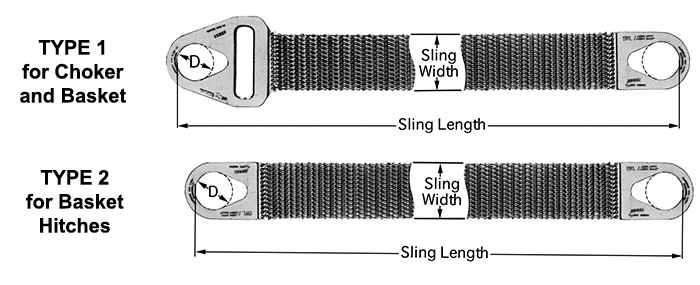
Contents
Sling – Metal Mesh slings
Metal mesh slings are widely used in metalworking and in other industries where loads are abrasive, hot, or will tend to cut web slings. Unlike nylon and wire rope slings, metal mesh slings resist abrasion and cutting. Metal mesh slings grip the load firmly without extensive stretching, easily maintaining balanced loads. Un coated metal mesh slings withstand temperatures up to 550 degrees F (288 degrees C).
Metal mesh slings combine alloy steel fittings joined to the steel mesh. Fittings are sometimes plated for protection and better visibility. Metal mesh slings have the following properties:
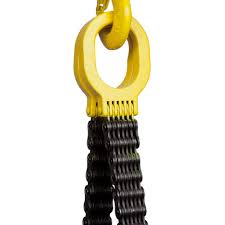
- Smooth, flat bearing surfaces,
- Carbon steel mesh that resists corrosion and abrasion, and
- Flexible mesh that conforms to irregular shapes.
Materials other than carbon steel are available for metal mesh slings, such as alloy steel for higher rated loads and stainless steel for corrosive environments.
Identification:
New slings are marked by the manufacture to show:
- The rated load for vertical basket hitch and choker hitch loadings.
In addition, slings may be marked to show:
- The rated load for the types of hitches, and the angle upon which they are based,
- The width and gauge, and
- The name or trademark of the manufacturer.
Rated loads:
Rated loads (capacities) for single-leg vertical, choker, and basket hitches are as shown in Table 17.
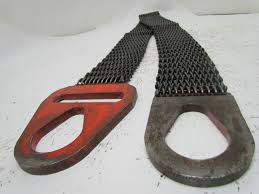
For angles not shown, use the next lower angle or a qualified person to calculate the rated load. Rated loads are based on:
- Material strength,
- Design factor,
- Type of hitch, and
- Angle of loading.
Do not use horizontal angles less than 30 degrees except as recommended by the sling manufacturer or a qualified person.
The rated load for a sling in a choker hitch is the value shown in Table 17, provided that the angle of the choke is 120 degrees or more. For angles of choke less than 120 degrees, use the rated loads provided by the sling manufacturer or a qualified person.
For other materials and for configurations not shown, use the rated loads provided by the sling manufacturer or a qualified person.
Attachments and components:
Use end fittings with a rated load that is at least the same as the metal mesh sling.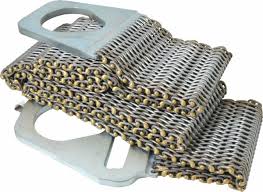
Ensure that end fittings have sufficient strength to sustain twice the rated load of the sling without visible permanent deformation.
Ensure that all surfaces of end fittings are cleanly finished and that sharp edges are removed.
Do not apply coatings that diminish the rated capacity of the sling.
Inspections:
Designate a qualified person to inspect slings and all fastenings and attachments each day before use for damage or defects.
This qualified person also performs additional periodic inspections where service conditions warrant, as determined on the basis of:
- Frequency of sling use,
- Severity of service conditions,
- Nature of lifts being made, and
- Experience gained during the service life of slings used in similar circumstances.
Make periodic inspections of metal mesh slings at intervals no greater than 12 months. A good guide to follow includes:
- Yearly for normal service use,
- Monthly to quarterly for severe service use, and
- As recommended by a qualified person for special and infrequent service use.
Although OSHA’s sling standard does not require you to make and maintain records of inspections, the ASME standard contains provisions on inspection records.
Make a thorough inspection of slings and attachments. Items to look for include:
- Broken wires in any part of the mesh,
- Broken weld or broken brazed joint along the sling edge,
- Reduction in wire diameter of 25 percent or more due to abrasion or 15 percent or more due to corrosion,
- Lack of flexibility due to distortion of the mesh,
- Distortion of the choker fitting so that the depth of the slot is increased by more than 10 percent,
- Distortion of either end fitting so that the width of the eye opening is decreased by more than 10 percent,
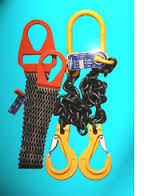
- A 15 percent or more reduction of the original cross-sectional area of any point around the hook opening of the end fitting,
- Visible distortion of either end fitting out of its plane,
- Cracked end fitting,
- Sling in which the spirals are locked or without free articulation,
- Fittings that are pitted, corroded, cracked, bent, twisted, gouged, or broken,
- Missing or illegible sling identifications, and
- Other conditions that cause doubt as to continued use of the sling.
Where any such defect or deterioration is present, remove the sling or attachment from service immediately.
Make a thorough inspection of slings and attachments. Items to look for include:
- Broken wires in any part of the mesh,
- Broken weld or broken brazed joint along the sling edge
- Reduction in wire diameter of 25 percent or more due to abrasion or 15 percent or more due to corrosion,
- Lack of flexibility due to distortion of the mesh,
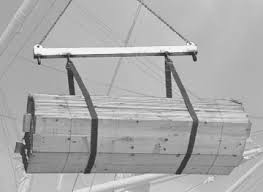
- Distortion of the choker fitting so that the depth of the slot is increased by more than 10 percent,
- Distortion of either end fitting so that the width of the eye opening is decreased by more than 10 percent,
- A 15 percent or more reduction of the original cross-sectional area of any point around the hook opening of the end fitting,
- Visible distortion of either end fitting out of its plane,
- Cracked end fitting,
- Sling in which the spirals are locked or without free articulation,
- Fittings that are pitted, corroded, cracked, bent, twisted, gouged, or broken,
- Missing or illegible sling identifications, and
- Other conditions that cause doubt as to continued use of the sling.
Where any such defect or deterioration is present, remove the sling or attachment from service immediately.
Table 17
Rated Load for Metal Mesh Slings
Based on Design Factor = 5
GENERAL NOTE: For choker hitch, the angle of choke is 120 deg or greater.
Rigging Practices:
- Ensure that the load is evenly distributed across the width of the metal mesh,
- Ensure that slings are hitched in a manner providing control of the load,
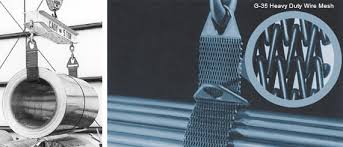
- Ensure that sharp edges in contact with slings are padded with material of sufficient strength to protect the sling,
- Ensure that slings are shortened or adjusted only by methods approved by the sling manufacturer or a qualified person,
- Ensure that, during lifting with or without a load, personnel are alert for possible snagging,
- Ensure that, in a basket hitch, the load is balanced to prevent slippage,
- When using a basket hitch, ensure that the legs of the sling contain or support the load from the sides, above the center of gravity, so that the load remains under control,
- Ensure that, in a choker hitch, the choke point is only on the sling body, never on a fitting,
- Ensure that, in a choker hitch, an angle of choke less than 120 degrees is not used without reducing the rated load,
- Ensure that slings are not constricted, bunched, or pinched by the load, hook, or any fitting,
- Ensure that, in a choker hitch, the load is balanced to prevent edge overload,
- Do not rest loads on the sling,
- Do not pull a sling from under a load when the load is resting on the sling,
- Do not drag slings on the floor or over abrasive surfaces,
- Do not straighten a spiral or cross rod or force a spiral into position,
- Ensure that slings used in pairs are attached to a spreader beam,
- Do not allow shock loading, and
- Avoid twisting and kinking.
Proof testing:
Before initial use, ensure that each new, repaired, or reconditioned metal mesh sling, including all welded components in the sling assembly, is proof tested by the sling manufacturer or a qualified person.
Ensure that coated slings are proof tested before the coating is applied.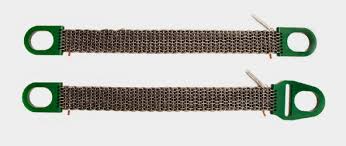
Environmental effects:
You may use metal mesh slings without a rated load reduction in temperatures ranging from minus 20 degrees F (minus 29 degrees C) to 550 degrees F (288 degrees C) except elastomer-coated slings.
You may only use elastomer-coated slings in temperature ranges of 0 deg F (minus 18 degrees C) to 200 degrees F (93 degrees C).
Consult the sling manufacturer for temperatures outside of these ranges.
Chemically active environments can affect the strength of metal mesh slings. Consult the manufacturer before using a sling in such environments.
Click the below link to download the safety check sheet for metal mesh sling
